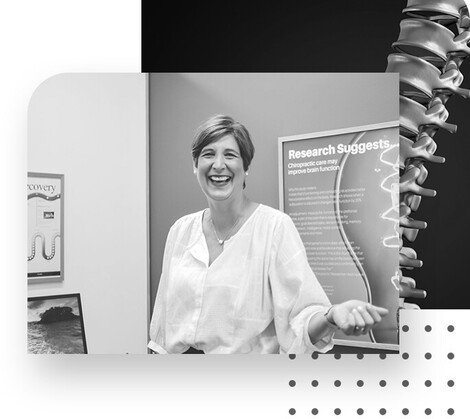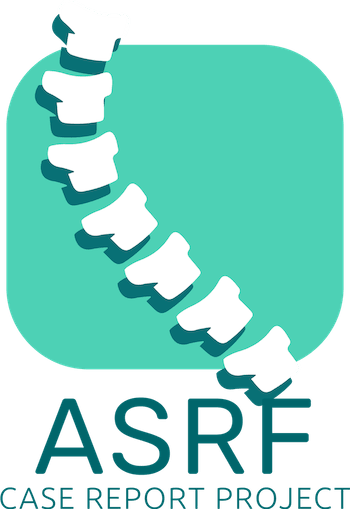
Section editor: Dr Charles Blum DC
The Chiropractic Assistant: A moment with Dad
The Dentist: The value of compassion in dentistry
The Physiatrist: The importance of compassion in a medical physiatry practice
The Psychotherapist: The value of compassion in the psychotherapeutic encounter
The Pragmatic Chiropractor: Compassion is the key to Patient Compliance and ‘paradigm shift acceptance’ for Chiropractic patients
The Acupuncturist: Compassion and conception: Back to the basics of being a person
The Chiropractic Clinician/Scientist: Channeling healing energy: The value of compassion in the chiropractic clinical setting
The Doctor of Physical Therapy: Healing Effects of Compassion
The Chiropractic Radiologist: Exercising compassion through chiropractic radiography & radiology
The Medical Urologist: The importance of compassion in a medical urology practice
Dukovac, Postlethwaite, McIvor: Improvement in adaptability concomitant with paediatric chiropractic care: A series of 5 cases
Dukovac, Postlethwaite, McIvor: Resolution of Breastfeeding Issues with present Tethered Oral Tissues concomitant with chiropractic care: A series of 7 cases
Dukovac, Postlethwaite, McIvor: Resolution of Infant Reflux Concomitant with Chiropractic Care: A series of 5 cases
Dukovac, Postlethwaite, McIvor: Paediatric Chiropractic care and improved Range of Motion: A limited case series
Masarsky & Todres-Masarsky: Long COVID Hyposmia/Parosmia and subluxation: A case report
Stephenson: Pregnancy following chiropractic care: A pre-case report
McCord & Schmitt: Acute pain & the Quintessential Applications clinical protocol

In Memoriam: Dr Phil Williams
Editorial: Bringing compassion back into chiropractic care and education
WCCS: Diversity Beliefs as a bridge for the future
Blum & Davis: A history of temporal sphenoidal (TS) diagnosis and its clinical application
Maffetone: Music, Brain, and Body: A clinical and scientific overview
Cuthbert: The GenitoUrinary system in chiropractic: The neuroanatomy of the muscle-organ-gland correlation
Ebrall: The establishment of the International College of Chiropractic (ICC) Melbourne
Masarsky Wide Angle Lens: Complex circuitry for complex machinery
‘his passion for chiropractic was contagious’
In 1969 Dr Phil Williams, a Palmer graduate and Gonstead practitioner, had purchased two adjacent houses in Perth WA and practised in one and lived in the other. Watching TV one evening he saw this beautiful young woman on Channel 7 who was presenting the weather, she was also hostess on the Channel 7 kid’s show. Her name was Trina Brown, the famous ‘Wink’ girl whose offsider on the kids’ show was Percy Penguin.
Phil decided there and then that he was going to marry Trina, despite the fact that she was a TV star and had won 2 Logies.
Well, he did, and they had 2 beautiful kids, Rebecca and Rohan.
This was an example of the optimistic and ‘go get ‘em’ approach that Phil always displayed during his active years as a chiropractor, especially in serving the Australian Chiropractor's Association.
Bringing compassion back into chiropractic care and education [Editorial]
Abstract: in this Post-Pandemic Age many of our once-trusted ways of doing things have gone, and the post-pandemic world is a little colder and harder for humans to negotiate. In turn this increases the need for a chiropractor to be a Beacon of Compassion in their community, and to put the ‘care’ back into ‘health-care’ and especially ‘chiropractic care’.
Where do we find compassion in chiropractic today? Certainly not within the standards offered for programmatic accreditation; of the 4 such sets of standards globally only those of the American CCE mention the word ‘subluxation’. The program standards of Canada, Europe, and Australia completely ignore subluxation and consequently dismiss the essential set of psychomotor skills required to identify and correct it, thus omitting the consummate expression of compassion. The proposed new standards of the GCC are no better.
I propose that subluxation-centric chiropractic is an effective way to express compassion and that it is up to each individual chiropractor to express compassion in their practice.
Indexing Terms: chiropractic; compassion; subluxation; education standards.
Cite: Ebrall P. Bringing compassion back into chiropractic care and education. URL Asia-Pac Chiropr J. 2022;3.1. URL apcj.net/Papers-issue-3.2/#EbrallEditorial2022Q4
'Moral Duty' is Chapter 1, in Palmer DD. The chiropractor. Los Angeles: Press of Beacon Light Printing Company. 1914. (public domain)
A moment with Dad
Abstract: The simplest advice for a Chiropractic Assistant is given in the words ‘The thing that matters most is that when each patient walks though that door that you make them feel warm, welcomed, and loved. It doesn’t matter if they come in grouchy, agitated, or unpleasant, just be kind to them. Have compassion for them.’ The precious person walking through the door is more important than all of those other jobs that need to be completed in any one day.
Indexing Terms: chiropractic; compassion; patient-focussed care.
Cite: Blum J. Compassion: A moment with Dad. URL Asia-Pac Chiropr J. 2022;3.2. URL apcj.net/Papers-Issue-3-2/#CompassionBlum
The value of compassion in dentistry
Abstract: More than knowledge or expertise in the chosen field of healthcare is necessary for proper patient care. humans and animals with higher functioning social groups need and seek out warmth, comfort or what may be translated as caring and compassion in their relationships. In essence we want to feel that someone is involved with us with their heart, not just their mind and knowledge.
Indexing Terms: chiropractic; dentistry; compassion; patient-focussed care.
Cite: Silkman R. The value of compassion in dentistry. URL Asia-Pac Chiropr J. 2022;3.2. URL apcj.net/Papers-Issue-3-2/#CompassionSilkman
The importance of compassion in a medical physiatry practice
Abstract: When health care providers deliver that help with empathy, patients feel validated and some will express immense appreciation. This can create a positive feedback loop where intimacy and trust are deepened and reinforced in the doctor-patient relationship, which is known to have a positive impact on therapeutic outcomes.
Indexing Terms: chiropractic; physiatry; compassion; patient-focussed care.
Cite: Aufiero D. The importance of compassion in a medical physiatry practice. URL Asia-Pac Chiropr J. 2022;3.2. URL apcj.net/Papers-Issue-3-2/#CompassionAufiero
The value of compassion in the psychotherapeutic encounter
Abstract: Compassion is not about disregarding the patient’s suffering, the challenges they are presented, or even the pain they are experiencing, but trying to hold a place for the health and wellness of the patient and speak to that during the therapeutic process.
Indexing Terms: chiropractic; psychotherapy; compassion; patient-focussed care
Cite: Blum JD. The value of compassion in the psychotherapeutic encounter. URL Asia-Pac Chiropr J. 2022;3.2. URL apcj.net/Papers-Issue-3-2/#CompassionJeffreyBlum
Compassion is the key to Patient Compliance and ‘paradigm shift acceptance’ for Chiropractic patients
Abstract: Purpose: To provide a qualitative report using accepted techniques from the Humanities of the place of compassion first in medical and health care and second in chiropractic care including my own practice.
Methods: A Narrative Analysis was undertaken of the literature expanding outwards from accepted definitions of ‘compassion’ to seek reported stories and studies whose actions are considered compassionate and were shown to be related to clinical outcomes. An Interpretative Phenomenological Analysis was made of conversations which reflected attitudes to expressed compassion. I was unable to develop a Thematic Analysis as the literature is sparse at this time, however Conversational Analysis together with Self-Reflection on my own clinical encounters allowed me to draw conclusions.
Conclusions: I report the beginning of a shift in the general approach to doctor / patient communication. Here I report a positive change in the healthcare system and in the health of the individual where patient interactions are guided by compassionate care. I argue for improvements in the definition and meaning of the terms: sympathy, empathy, and compassion; these need to be well defined to eliminate current confusion in the literature. It is recommended that compassionate care must be integrated into the healthcare education system and institutions if this profound change in healing, not just curing, is to occur. Chiropractic care and the Chiropractic paradigm in particular might benefit greatly by the investment of time and energy in compassionate care training. Further studies concerning the ability to develop compassion as well as select individuals with compassion are needed.
Indexing Terms: chiropractic; paradigm shift; compassion; patient-focussed care
Cite: Weiner G. Compassion is the key to Patient Compliance and ‘paradigm shift acceptance’ for Chiropractic patients. Asia-Pac Chiropr J. 2022;3.2. URL apcj.net/Papers-Issue-3-2/#CompassionWeiner
Compassion and conception: Back to the basics of being a person
Abstract: It’s easy to get caught up in the clinical side of lab results, range of motion tests, pain scales, and whatnot, and we tend to forget the big picture: to recognise the reason why they really came to us for care in the first place. We can help their journeys be one of growth and appreciation for their extenuating circumstances. That no matter the result, they reach that destination as an individual that values themselves, believes in their worth, and carries the conviction that they were born to win. It is not about what you get at the end, but whom you get to become by the end of it
Indexing Terms: chiropractic; acupuncture; compassion; patient-focussed care
Cite: Jafari K. Compassion and conception: Back to the basics of being a person. URL Asia-Pac Chiropr J. 2022;3.2. URL apcj.net/Papers-Issue-3-2/#CompassionJafari
Channeling healing energy: The value of compassion in the chiropractic clinical setting. Part one
Abstract: Compassion is about what we leave for others during these brief magically moments we are alive, it is about trying to have compassion for my shadow and that of others, and realising that we are all doing the best we can. By bringing these insights into the clinical encounter with kindness, compassion, and caring then our patients can feel safe and we can focus on our patient’s optimal wellbeing and better channel our healing energy.
Indexing Terms: chiropractic; chiropractor; compassion; patient-focussed care.
Cite: Blum C. Channeling healing energy: The value of compassion in the chiropractic clinical setting. Part one. URL Asia-Pac Chiropr J. 2022;3.2. URL apcj.net/Papers-Issue-3-2/#CompassionCharlesBlum
Healing effects of compassion
Abstract: Our patients are the ones who have lived in their body through the ups and downs of their injuries; pain, and emotion come with this. We must work together, creating a plan of action and beginning a targeted treatment that is meaningful. When a patient senses the healthcare practitioner is invested in them, true healing can begin.
Indexing Terms: chiropractic; physical therapy; compassion; patient-focussed care
Cite: Carr E. Healing effects of compassion. URL Asia-Pac Chiropr J. 2022;3.2. URL apcj.net/Papers-Issue-3-2/#CompassionCarr
Exercising compassion through chiropractic radiography and radiology
Abstract: Chiropractors exercise compassion through their care and at times there may be indications seen on a patient’s X-rays that could modify or withhold such care. A radiologist’s opinion can allow adjustive care to be applied by the clinician as clinically indicated. This care reports a patient with a vertebral hemangioma.
Indexing Terms: chiropractic; radiology; radiography; compassion; vertebral hemangioma
Cite: Tao C. Exercising compassion through chiropractic radiography & radiology. URL Asia-Pac Chiropr J. 2022;3.2. URL apcj.net/Papers-Issue-3-2/#CompassionTao
The importance of compassion in a medical urology practice
Abstract: Patients arrive with emotions and often the main ones are anxiety and fear. Compassion cools the temperature. Patients will immediately sense your compassion, they will listen and engage much better. This invariably leads to better outcomes.
Indexing Terms: chiropractic; urology; compassion; patient-focussed care; medical practice
Cite: Jurige Jr JH. The importance of compassion in a medical urology practice. URL Asia-Pac Chiropr J. 2022;3.2. URL apcj.net/Papers-Issue-3-2/#CompassionJurige
Improvement in adaptability concomitant with paediatric chiropractic care: A series of 5 cases
Abstract: Objective/Clinical Features: Four cases addressing chiropractic care and sleep, energy and behaviour are presented, with diversified technique as the primary method of reducing subluxations.
Intervention/Outcome: Subluxation-based care was delivered via diversified technique with care plans tailored to meet parent and chiropractor recommendations.
Conclusion: Chiropractic care for the reduction of subluxations may contribute to enhanced nervous system coherence, thus allowing the child to better adapt to their environment, resulting in better sleep and behaviour. In terms of the research agenda of the ASRF these cases demonstrate an improvement is patient adaptability seems associated with subluxation correction. Further research is required to understand the mechanisms behind these improvements.
Indexing Terms: Chiropractic; Subluxation; breastfeeding; case report; case series; adaptability
Cite: Dukovac N, Postlethwaite R, McIvor C. Improvement in adaptability concomitant with paediatric chiropractic care: A series of 5 cases. Asia-Pac Chiropr J. 2022;3.2. URL apcj.net/Papers-Issue-3-2/#DukovacAdaptability
Resolution of Breastfeeding Issues with present Tethered Oral Tissues concomitant with chiropractic care: A series of 7 cases
Abstract: Objective/Clinical Features: This case series covers seven cases where breastfeeding issues presented with tethered oral ties, both of which improved concomitant with subluxation-based chiropractic care.
Intervention/Outcome: Chiropractic care for the reduction of subluxation was delivered via diversified technique, modified to suit the age, size and tensile strength of the infant, and complemented by dural stretches, and oral soft tissue therapy. Across all cases, improvements in breastfeeding outcomes and/or tethered oral tissues were noted.
Conclusion: While the attending chiropractor makes no claim to fixing oral ties, rather than subluxation-based care may improve neural connection and reduce cervical subluxations resulting in improved oral muscle tone and breastfeeding outcomes. Further research is required.
Indexing Terms: Chiropractic; Subluxation; breastfeeding; case report; case series; Tethered Oral Tissues.
Cite: Dukovac N, Postlethwaite R, McIvor C. Resolution of Breastfeeding Issues with present Tethered Oral Tissues concomitant with chiropractic care: A series of 7 cases. Asia-Pac Chiropr J. 2021;2.6. URL apcj.net/Papers-Issue-3-2/#DukovacBreastfeeding
Resolution of Infant Reflux Concomitant with Chiropractic Care: A series of 5 cases
Abstract: Objective/Clinical Features: Colic and reflux are common complaints for infants and neonates, and both conditions represent potentially complex aetiologies. From a chiropractic standpoint, subluxation-based care that ensures optimal oral function and suck-swallow coordination is of value for supporting mothers and babies dealing with reflux. Also, reducing physical stress on the nervous system via vertebral subluxation reduction may change the infant from being in sympathetic nervous system overdrive to a more balanced state with parasympathetic system, allowing for decreased sensitivity of gag reflex, and improved function of digestive system.
Intervention/Outcome: Subluxation-based care of five infants with colic and/or reflux, using modified diversified technique and oral soft tissue therapy was concomitant with a significant reduction or complete resolution of colic or reflux.
Conclusion: Chiropractic care for the reduction of subluxations may support digestive processes and gag reflex sensitivity via restoring balance between sympathetic and parasympathetic systems. as well as improved suck swallow reflex coordination in infants.
Indexing Terms: Chiropractic; Subluxation; breastfeeding; case report; case series; reflux
Cite: Dukovac N, Postlethwaite R, McIvor C. Resolution of Infant Reflux Concomitant with Chiropractic Care: A series of 5 cases. Asia-Pac Chiropr J. 2022;3.2. URL apcj.net/Papers-Issue-3-2/#DukovacInfantReflux
Paediatric Chiropractic care and improved Range of Motion: A limited case series
Abstract: Objective/Clinical Features: This limited case series presents two infants who were born via long or assisted labours, who went on to experience issues related to range of motion. They underwent subluxation-based chiropractic care using diversified techniques which were modified for their age and tensile strengths.
Intervention/Outcome: A reduction in subluxation listings was concomitant with an increase in range of motion and/or a resolution of shoulder dystocia and other subjective improvements self-reported by parents.
Conclusion: Birth is a significant event for both mother and baby. Given the prevalence of restricted range of motion in infants, chiropractic care may be considered a positive care modality for infants who have limited range of motion or birth trauma. Further research is required.
Indexing Terms: Chiropractic; Subluxation; breastfeeding; case report; case series; infant range of motion; ROM
Cite: Dukovac N, Postlethwaite R, McIvor C. Paediatric Chiropractic care and improved Range of Motion: A limited case series. Asia-Pac Chiropr J. 2022;3.2. URL apcj.net/Papers-Issue-3-2/#DukovacInfantROM
Long COVID Hyposmia/Parosmia and subluxation: A case report
Abstract: A 58-year-old woman with long COVID manifestations is described. Her symptoms included hyposmia, parosmia, brain fog, fatigue, and dry mouth. On examination, Weber’s test was positive, with lateralization to the right ear. Reverse digit span was 5. On the Gupta et al olfactory scale of “0” (unable to smell anything) to “5” (completely normal sense of smell), she rated her ability to smell as “1”. She was generally able to smell most aromas for one to two “sniffs” only. At various times, with no apparent pattern or external cause, she would experience a “house on fire” odor. Palpation augmented by Applied Kinesiology challenge revealed upper cervical, right first rib, right sacroiliac, and sphenoid subluxation. Ten adjustments were administered over a six-week period, consisting of high velocity low amplitude maneuvers, and various minimal force adjustments and reflex therapies. The levels of intervention varied according to the treating doctor’s findings on a visit-to-visit basis. The patient was also advised to take coenzyme Q-10 and B-complex supplements to compensate for the effect of her statin prescription on coenzyme Q-10 biosynthesis. By her tenth visit, Weber’s test was negative, her brain fog was gone, reverse digit span was 6, she rated her sense of smell between 2 and 3 out of a possible 5, she was able to detect aromas for as many as 4 “sniffs” in a row. The “house on fire” odor had transformed into a “burnt popcorn” odor. The patient’s experience of dry mouth and fatigue were no longer more pronounced than they had been before COVID-19 infection. Possible mechanisms of the patient’s recovery are discussed, with hypotheses relevant to future long COVID research.
Indexing Terms: Chiropractic; Long Haul COVID; Hyposmia; Parosmia; subluxation
Cite: Masarsky CS, Todres-Masarsky M. Long COVID Hyposmia/Parosmia and subluxation: A case report. Asia-Pac Chiropr J. 2022;3.2. URL apcj.net/Papers-Issue-3-2/#MasarskyHyposmia
Pregnancy following chiropractic care: A pre-case report
Abstract: 26yo female who suffered with lower back pain (since her first child was born six years earlier), neck pain and chronic headaches struggled for two years to become pregnant with a one-testicled man, even though she’d already borne two children with no problems becoming pregnant. With the aid of three months of regular Chiropractic care she unexpectedly became pregnant and subsequently gave birth to a healthy baby. Chiropractic adjustments in the Gonstead Methods appropriately modified for her age, somatotype, and disposition were typically given at segments L5 as PLS-sp, T10 as PLI-T, T4 as PRS-sp and C6 as PRS-sp. Stress was also a major factor for this patient along with chronic ear infections.
Indexing Terms: Pregnancy; subluxation; lower back pain'; ear infection; stress; Gonstead Methods
Cite: Stephenson R. Pregnancy following chiropractic care:A pre-case report. Asia-Pac Chiropr J. 2022;3.2. URL apcj.net/Papers-Issue-3-2/#StephensonPregnancy
Acute pain & the Quintessential Applications clinical protocol
Abstract: A case history of a 39y male carpenter with acute shoulder pain is presented demonstrating the practical application of the Quintessential Applications (QA) Clinical Protocol in the evaluation and treatment of a patient in acute pain.
Indexing Terms: chiropractic; AK; Applied Kinesiology; Quintessential Applications (QA) Clinical Protocol; acute pain; shoulder
Cite: McCord KM, Schmitt WH. Acute pain & the Quintessential Applications clinical protocol. Asia-Pac Chiropr J. 2022;3.2 URL apcj.net/Papers-Issue-3-2/#McCordSchmittAcutePainProtocol
Diversity Beliefs as a bridge for the future
The future is good
Abstract: Chiropractic practitioners have the potential to help create space and acceptance for their patients, but what about each other? Chiropractic has a large spectrum when it comes to defining what is chiropractic. One side has a vitalistic view while the other is mechanistic, plus everything in between. The vitalistic chiropractors use the term vertebral subluxation and depending on how deep you want to take it, some have a more spiritual viewpoint. While the mechanistic viewpoint mainly focuses on the physical body and uses the term manipulation or moving a segment in space.
What if diversity is a key for improving the future of humanity, even chiropractic?
Indexing terms: chiropractic; WCCS; diversity; vitalism; mechanism
Cite: Paul C. Diversity Beliefs as a bridge for the future. Asia-Pac Chiropr J. 2022;3.2. URL apcj.net/papers-issue-3-2/#PaulWCCS
A history of temporal sphenoidal (TS) diagnosis and its clinical application
Abstract: Rees studied the TS points extensively and attempted to determine how these reflex points might relate to the body and be used for diagnosis and guiding treatment. His initial theory suggested that the TS points on the skull helped to monitor messages sent from a vital organ as sensory feedback to the brain. He believed that these messages could be measured by an EEG (Rees used an oscilloscope) as micro-voltages of an alpha wavelength. Therefore when an organ was stressed, the matching TS point had an imbalance of alpha wave production compared to the other points, thus setting up a local hyper-excitability or reduced inhibition effect on the active TS point.
From this came a method Rees termed the ‘Alpha Wave Enhancement’ technique to address this imbalance and facilitate both afferent and efferent supra-spinal visceral communication.
Cite: Blum C, Davis KY. A history of temporal sphenoidal (TS) diagnosis and its clinical application. Asia-Pac Chiropr J. 2022;3.2 URL apcj.net/papers-issue-3-2/#DavisTemporalSphenoidClinicalNote
Music, Brain, and Body: A clinical and scientific overview
Abstract: Listening to music can quickly engage or light up the whole brain. Both creating and listening to music is instinctual, and can influence physical, biochemical, and mental-emotional brain and body health in many ways through the nervous system, affecting hormones, stress, movement, and virtually all systems of the body. As such, music can serve as a valuable adjunct for people of all ages, including chiropractors and their patients. Music can have profound therapeutic actions in simple ways, from merely listening to songs to related basic biofeedback techniques. These and other topics are presented.
Indexing Terms: music; therapy; chiropractic; brain injury
Cite: Maffetone P. Music, Brain, and Body: A clinical and scientific overview. Asia-Pac Chiropr J. 2022;2.6. URL apcj.net/Papers-Issue-3-2/#MaffetoneMusic
The GenitoUrinary system in chiropractic: The neuroanatomy of the muscle-organ-gland correlation
Abstract: As used in chiropractic applied kinesiology (AK), manual muscle testing (MMT) procedures are diagnostic tools in the examination of a system frequently ignored and even unexamined by traditional physicians today: the reproductive system of both men and women. Using AK MMT we can work directly with the position, motion, innervation, nutritional needs, tissue tone and functional capacity of the reproductive organs, their motor nerves, as well as their adjacent and supportive tissues. AK MMT procedures permit us to restore proper tone and structure/function relationships throughout this critical area, and to improve its potential for health. The genito-urinary system needs not be viewed differently than other body systems, i.e., it does not need to be ignored as a specific clinical entity and therapeutic target of care.
This paper argues that it makes no sense for the chiropractic profession to deliberately shy away from the genito-urinary system in its patient recruitment, history taking, functional examinations or therapeutics. We possess methods within our therapeutic system that permit us to evaluate and treat the genito-urinary system – with respect, reverence, sensitivity, and skill. Visual and laboratory inspection of the tissues and fluids of the reproductive organs is only one aspect of the proper evaluation of this integrative neuro-endocrine system.
The relationship of applied kinesiology to the endocrine system is one that creates success for the clinician where other manual modalities might fall short. Each of the endocrine organs has been given diagnostic tests, therapeutic protocols, nutritional correlations, and treatment monitoring methods. The endocrine glands are of course controlled by the nervous system, and this is why chiropractic has proven to be helpful throughout its history for endocrine-related disorders.1 But applied kinesiology offers an exhaustive and repeatably accurate way to monitor both the endocrine symphony and the effect of our natural therapies upon it. This system of chiropractic diagnosis and treatment offers us as much endocrinology for the general practitioner as will be found anywhere.
Indexing Terms: Piriformis; genitourinary; manual muscle test; muscle imbalance; Applied Kinesiology (AK); diagnosis.
Cite: Cuthbert S. The GenitoUrinary system in chiropractic: The neuroanatomy of the muscle-organ-gland correlation. Asia-Pac Chiropr J. 2022;3.2. URL apcj.net/Papers-Issue-3-2/#CuthbertPiriformis
The establishment of the International College of Chiropractic (ICC) Melbourne.
Abstract: The purpose of this pragmatic historical narrative is to report events leading to the establishment of the first program of education by chiropractors for chiropractors in Australasia. The mainstream chiropractors in Australia formed an independent education body incorporated on 6 March 1975 as the International College of Chiropractic (ICC). The anchor years are the early 1970s to 1975 during which the ICC went from an idea to a reality in a very short time. It then transitioned from a private, stand-alone fee-for-education institution to be within a state tertiary education system which resulted in government funding for student places. The evidence strongly supports my contention that the ICC marked the commencement of chiropractic education in Australia.
Indexing Terms: chiropractic; history; Australia; Government Inquiries; identity; education.
Cite: Ebrall P. The establishment of the International College of Chiropractic (ICC) Melbourne. Asia-Pac Chiropr J. 2022;3.2. URL apcj.net/Papers-Issue-3-2/#ICC
Wide angle lens: Complex Circuitry for Complex Machinery
Abstract: Practitioners who adjust the upper cervical area are generally aware of the potential benefit of this service in terms of vagal function. This is because of the proximity of the vagus n to the occipital condyles as it exits the jugular foramen. What is not always appreciated is the potential for mid-cervical and lower thoracic adjustments to benefit the vagus as well, due to the relation of that nerve to the diaphragm. If the chiropractic adjustment did nothing but improve diaphragm function, the whole-body benefits of our service would already have ample explanation.
Indexing Terms: chiropractic; diaphragm; adjustment; subluxation
Cite: Masarsky CS. Complex Circuitry for Complex Machinery [The wide-angle lens]. Asia-Pac Chiropr J. 2022;3-2. URL apcj.net/Papers-Issue-3-2/#MasarskyDiaphragm
Disclaimer
This journal is a professional journal by chiropractors for chiropractors. Readers not fully trained as a chiropractor should not act on their own on any information published in these pages and should always discuss their situation with their chiropractor.
The papers addressing COVID report current information at their time of writing. The topic is fast moving and readers are encouraged to extract threads from what we publish here and undertake their own searches for the most recent information.












